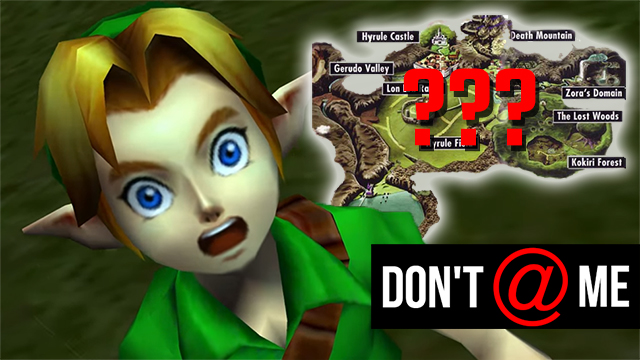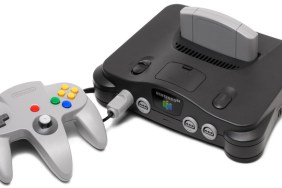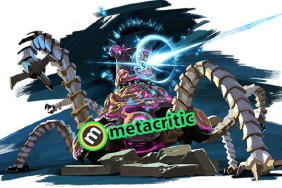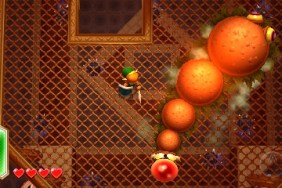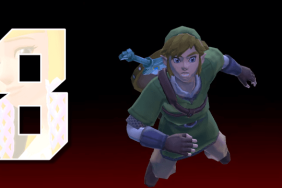Time has been both kind and unkind to The Legend of Zelda: Ocarina of Time. It has some incredible moments that make it easy to see why it’s so beloved. But as I played the 3DS remake, it became clear that certain elements just haven’t aged well. It all comes down to the fact that Ocarina of Time takes place in an expansive, relatively open world but often requires completing extremely specific actions to progress. These actions are sometimes frustrating simply because there’s little to point players in the right direction. More often, though, it’s a combination of this and a lack of logical narrative motivation to contextualize characters’ actions. These missteps make Ocarina of Time a pain in the ass to traverse.
The classic example of Ocarina of Time‘s unclear progression is the process of entering the “Inside Jabu Jabu’s Belly” dungeon. To get inside, you have to complete a minigame in Zora’s Domain, swim through an underwater tunnel to Lake Hylia, find Princess Ruto’s S.O.S. message in a bottle, show the message to King Zora, use the bottle to capture a fish, and feed the fish to Jabu Jabu to get him to swallow you. It’s a fairly roundabout way of accessing the dungeon, but at least the final steps make logical sense. Why do you need to get inside the sea monster? To rescue the King’s daughter. How do you get the sea monster to open his mouth? Feed him. But Ocarina of Time has far worse instances of vague progression later in the game that aren’t as easy to follow.
ALSO: How Control learned from Dark Souls to trust its players
Finding the way forward
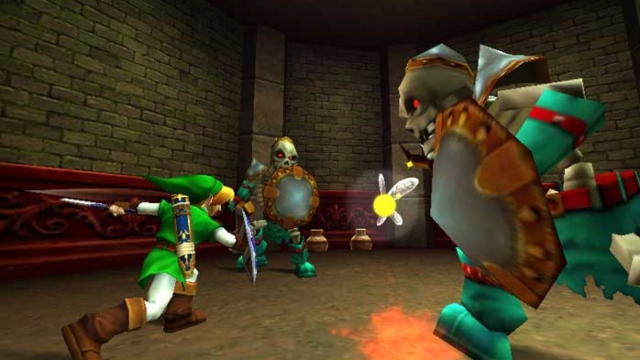
Take, for example, the path to the Spirit Temple. Because of a mark on the map, the player knows there’s a dungeon in the Gerudo region, but the only reason for Link to go there within the story is that Navi keeps telling him something to the extent of, “Hey, Ganondorf is from the desert. We might find something if we go there.” He has no reason to think there’s a Sage in Gerudo other than knowing it’s the final area of the game, and Link doesn’t even have a personal reason to go there. Most of the other adult-era dungeons at least have something to do with NPCs he’s previously encountered: Link goes to the Fire Temple in order to free the Gorons and to the Water Temple in the hopes of defrosting the Zora, both races he bonded with as a child.
When you arrive in the Gerudo Valley, you discover there’s a fortress full of hostile Gerudo warriors that will imprison Link on sight. My initial thought was that I might be able to sneak through to the desert beyond, beelining it past the warriors to the final temple. Nope. Instead, with no way to get past the Gerudo, your only option is to sneak through their fortress and set their dense carpenter prisoners free. Logically, why would actively antagonizing the Gerudo lead to them letting Link through to the desert? Once you’ve freed the carpenters, a Gerudo warrior explains that they’re impressed with Link’s skills, so they’ll give him free access to the fortress and its entrance to the desert. This sort of makes sense, but the player had no way of knowing this would happen. All you can do is go to Gerudo Valley — because there’s no other option. Free the prisoners — because there’s no other option.
All of this wouldn’t have been so bad if Ocarina of Time had just accepted the fact that it’s a linear, story-focused game. Instead, it presents players with a semi-open world and gives them the illusion of freedom, which leads to weird story holes like this. These story holes affect the gameplay and require that players use some nonsensical moon logic to progress. Old games are often revered for good reason, but these mishaps are hard to overlook in 2019.
Big worlds, little direction
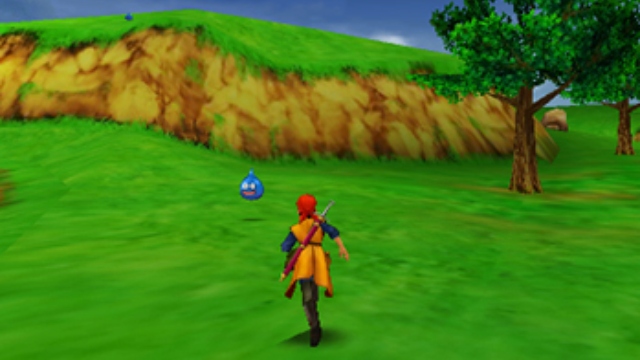
Other critically acclaimed games from the era are just as obtuse. For example, the 3DS remake of 2004’s Dragon Quest 8: Journey of the Cursed King takes this problem to the extreme, setting similarly obscure progression requirements in a much bigger world. There are lots of points in the early game where you run into situations like Ocarina’s Gerudo Valley blunder, but a particularly annoying segment comes when you have to get the Godbird to go after the story’s antagonist near the game’s climax. It takes a ton of logical leaps that wouldn’t even clear the shortest of hurdles in 2019.
Both Ocarina of Time and Dragon Quest 8 have open structures but aren’t open-ended. Their specific progression requirements and large worlds lead to what is essentially the 3D equivalent of pixel hunting in old-school, point-and-click adventure games. Rather than using logic to figure out the next step, you’re forced to blindly wander around, hoping to find a vague hint about how to progress. Navi gets a lot of flack for holding players’ hands too much, but she’s just a symptom of the real issue. She’s mostly there to patch up the holes in Ocarina of Time’s story, unnaturally telling Link where he’ll find the next plot point in lieu of a natural, clever transition from location to location.
Modern open-world games have, for the most part, fixed these problems. They’ve introduced more thoughtful narrative context for progression requirements and, most importantly, made their worlds actually fun to explore. This helps ensure that players aren’t simply wandering in search of plot points but wandering just to wander, naturally coming upon story progression as they go. The Legend of Zelda: Breath of the Wild even went a step further by basically removing plot progression altogether. After the Great Plateau, all Link has to do is defeat Ganon. Any story points you run into along the way are just extra, optional context, and, crucially, everything you miss doesn’t truly matter.
There’s still a lot to like about these games. Ocarina of Time has great dungeon designs like the 3DS-improved Water Temple and set pieces like the Dark Link encounter and Bongo Bongo boss fight, which are impressive even by today’s standards. Dragon Quest 8 has an engaging combat system (when you’re fighting bosses, at least) and interesting characters. But it’s hard to ignore their obnoxiously vague progression, especially when juxtaposed against modern games that have it figured out. Comparing new and old games like this may not be fair, but that doesn’t make it any less true. When I look back on my experiences, I see the good times, but I also see the many, many times I opened my phone to look up a guide when I’d had it with each game’s bullshit.
